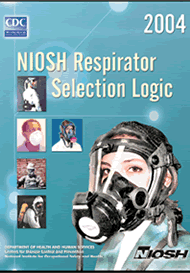Chapter V. Additional Information
on Hazards and Exposures
The following subparagraphs provide
additional information to assist the reader in using the Respirator
Selection Logic Sequence.
Subparagraph 1:
Oxygen-Deficient Atmosphere
NIOSH defines an oxygen-deficient atmosphere as any atmosphere
containing oxygen at a concentration below 19.5% at sea level. NIOSH
certification of supplied-air or air-purifying respirators is
limited to those respirators used in atmospheres containing at least
19.5% oxygen, except for those supplied-air respirators equipped
with auxiliary self-contained breathing apparatus (SCBA).
The minimum requirement of 19.5% oxygen at sea level provides an
adequate amount of oxygen for most work assignments and includes a
safety factor. The safety factor is needed because oxygen-deficient
atmospheres offer little warning of the danger, and the continuous
measurement of an oxygen-deficient atmosphere is difficult.
At oxygen concentrations below 16% at sea level, decreased mental
effectiveness, visual acuity, and muscular coordination occur. At
oxygen concentrations below 10%, loss of consciousness may occur,
and below 6% oxygen, death will result. Often only mild subjective
changes are noted by individuals exposed to low concentrations of
oxygen, and collapse can occur without warning.
Since oxygen-deficient atmospheres are life-threatening, only the
most reliable respirators are recommended; the most reliable
respirators are the self-contained breathing apparatus or the
supplied-air respirators with auxiliary self-contained units.
Because a high protection factor is not necessary to ensure an
adequate supply of oxygen even in an atmosphere containing no
oxygen, any certified self-contained unit is adequate. All aspects
of a respiratory protection program must be instituted for these
recommendations to be valid.
Subparagraph 2: Exposure
Limits
The legal, enforceable exposure limit is the permissible exposure
limit (PEL) set by OSHA. NIOSH develops recommended exposure limits
(RELs) for hazardous substances. To formulate these recommendations,
NIOSH evaluates all known available medical, biological and
engineering, chemical trade, and other information relevant to the
hazard. Other exposure limits that can be considered in making
respirator selections include State-OSHA exposure limits (e.g.,
California), ACGIH TLVs, AIHA WEELs, corporate exposure limits, etc.
The effectiveness of this RSL is limited to the adequacy of the
selected exposure limits in protecting the health of workers.
Exposure limits based on a thorough evaluation of more recent or
extensive data should be given priority.
For all chemicals that cause irritation or systemic effects but
do not cause carcinogenic effects, it is currently believed that a
threshold exposure concentration exists such that virtually all
persons in the working population (with the possible exception of
hypersensitive individuals) would experience no adverse health
effects.
Other variables such as the specific situation, worker, or job
may influence the selection of the appropriate exposure limit for a
given contaminant. For example, the effects of some hazardous
substances may be increased due to exposure to other contaminants
present in the workplace or the general environment or to
medications or personal habits of the worker. Such factors, which
would affect the toxicity of a contaminant, would not have been
considered in the determination of the specific exposure limit.
Also, some substances are absorbed by direct contact with the skin
and mucous membranes, thus potentially increasing the total
exposure.
Subparagraph 3: Immediately
Dangerous to Life or Health (IDLH)
An IDLH exposure condition is one that poses a threat of exposure
to airborne contaminants when that exposure is likely to cause death
or immediate or delayed permanent adverse health effects or prevent
escape from such an environment. The purpose of establishing an IDLH
exposure level is to ensure that the worker can escape from a given
contaminated environment in the event of failure of the respiratory
protection equipment. The IDLH is considered a maximum level above
which only a highly reliable breathing apparatus providing maximum
worker protection is permitted. Any appropriate approved respirator
may be used to its maximum use concentration up to the IDLH
concentration.
In establishing the IDLH concentration, the
following conditions must be assured:
a. The ability to escape without loss of life or
immediate or delayed irreversible health effects. (Thirty minutes is
considered the maximum time for escape so as to provide some margin
of safety in calculating the IDLH.)
b. The prevention of severe eye or respiratory
irritation or other reactions that would hinder escape.
Sources of information for determining whether the exposure limit
for a contaminant represents an IDLH condition are as follows:
a. Specific IDLH guidelines provided in the
literature such as the NIOSH Pocket Guide for Hazardous Chemical
Substances (http://www.cdc.gov/niosh/npg/npg.html)
and the American Industrial Hygiene Association (AIHA) Hygienic
Guides.
b. Human exposure and effects data, and/or
c. Animal exposure and effects data,
and/or
d. Where such data specific to the contaminant
are lacking, toxicologic data from analogous substances and chronic
animal exposure data may be considered.
Subparagraph 4: Eye
Irritation
Eye protection in the form of respirators with full facepieces,
helmets, or hoods is required for routine exposures to airborne
contaminants that cause any irritation to the mucous membranes of
the conjunctivae or the cornea or cause any reflex tearing. Eye
protection is required for contaminants that cause minor subjective
effects as well as for those that cause any damage, including
disintegration and sloughing of conjunctival or corneal epithelium,
edema, or ulceration. NIOSH is not aware of any standards for
gas-tight goggles that would permit NIOSH to recommend such goggles
as providing adequate eye protection.
For escape, some eye irritation is permissible if the severity of
irritation does not inhibit the escape and if no irreversible
scarring or ulceration of the eyes or conjunctivae is likely.
When data on threshold levels for eye irritation are
insufficient, quarter or half-mask respirators can be used, provided
that the worker experiences no eye discomfort and no pathologic eye
effects develop. Workers should be told that if any eye discomfort
is experienced, they will be provided with respirators that have
full facepieces, helmets, or hoods and that provide protection
equivalent to the quarter- or half-mask respirators.
| 

